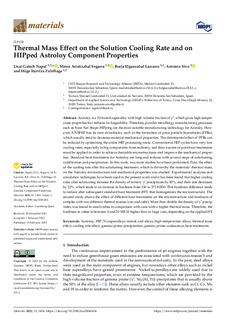| dc.rights.license | Attribution 4.0 International | * |
| dc.contributor.author | Elguezabal Lazcano, Borja | |
| dc.contributor.other | Galech Napal, Unai | |
| dc.contributor.other | Aristizabal Segarra, Miren | |
| dc.contributor.other | Sivo, Antonio | |
| dc.contributor.other | Iturriza Zubillaga, Iñigo | |
| dc.date.accessioned | 2024-05-14T15:27:05Z | |
| dc.date.available | 2024-05-14T15:27:05Z | |
| dc.date.issued | 2022 | |
| dc.identifier.issn | 1996-1944 | en |
| dc.identifier.other | https://katalogoa.mondragon.edu/janium-bin/janium_login_opac.pl?find&ficha_no=177405 | en |
| dc.identifier.uri | https://hdl.handle.net/20.500.11984/6411 | |
| dc.description.abstract | Astroloy is a Ni-based superalloy with high-volume fraction of γ′, which gives high temperature properties but reduces its forgeability. Therefore, powder metallurgy manufacturing processes such as Near Net Shape HIPping are the most suitable manufacturing technology for Astroloy. However, NNSHIP has its own drawbacks, such as the formation of prior particle boundaries (PPBs), which usually tend to decrease material mechanical properties. The detrimental effect of PPBs can be reduced by optimizing the entire HIP processing route. Conventional HIP cycles have very low cooling rates, especially in big components from industry, and thus a series of post-heat treatments must be applied in order to achieve desirable microstructures and improve the mechanical properties. Standard heat treatments for Astroloy are long and tedious with several steps of solutioning, stabilization and precipitation. In this work, two main studies have been performed. First, the effect of the cooling rate after the solutioning treatment, which is driven by the materials’ thermal mass, on the Astroloy microstructure and mechanical properties was studied. Experimental analyses and simulation techniques have been used in the present work and it has been found that higher cooling rates after solutioning increase the density of tertiary γ′ precipitates by 85%, and their size decreases by 22%, which leads to an increase in hardness from 356 to 372 HB30. This hardness difference tends to reduce after subsequent standard heat treatment (HT) that homogenizes the microstructure. The second study shows the effect of different heat treatments on the microstructure and hardness of samples with two different thermal masses (can and cube). More than double the density of γ′ precipitates was found in small cubes in comparison with cans with a higher thermal mass. Therefore, the hardness in cubes is between 4 and 20 HB 30 higher than in large cans, depending on the applied HT. | en |
| dc.language.iso | eng | en |
| dc.publisher | MDPI | en |
| dc.rights | © 2022 The Authors | en |
| dc.rights.uri | http://creativecommons.org/licenses/by/4.0/ | * |
| dc.subject | Astroloy | en |
| dc.subject | Ni superalloys | en |
| dc.subject | metals and alloys | en |
| dc.subject | high-temperature alloys | en |
| dc.subject | thermal mass effect | en |
| dc.subject | cooling rate | en |
| dc.subject | gamma prime precipitation | en |
| dc.subject | gamma prime coalescence | en |
| dc.subject | heat treatments | en |
| dc.title | Thermal Mass Effect on the Solution Cooling Rate and on HIPped Astroloy Component Properties | en |
| dc.type | http://purl.org/coar/resource_type/c_6501 | |
| dcterms.accessRights | http://purl.org/coar/access_right/c_abf2 | en |
| dcterms.source | Materials | en |
| local.description.peerreviewed | true | en |
| local.identifier.doi | https://doi.org/10.3390/ma15041434 | en |
| local.contributor.otherinstitution | https://ror.org/022wqqf69 | en |
| local.contributor.otherinstitution | https://ror.org/00bgk9508 | en |
| local.contributor.otherinstitution | Tecnun | en |
| oaire.format.mimetype | application/pdf | en |
| oaire.file | $DSPACE\assetstore | en |
| oaire.resourceType | http://purl.org/coar/resource_type/c_6501 | en |
| oaire.version | http://purl.org/coar/version/c_970fb48d4fbd8a85 | en |








